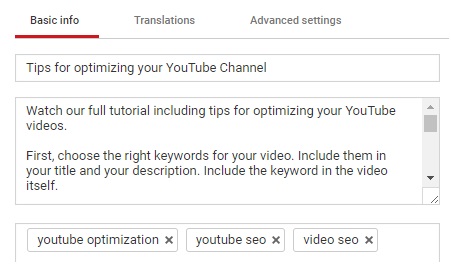How to optimize a YouTube video for search engine optimization starts with keywords. You must research the keywords for which you want to rank, create an eye-catching title, subtitle, and chapter, and include a maximum of 5-8 targeted tags. The keywords used should include the primary keyword first, common variations, and one or two long-tail keywords. In addition, you should use the most effective title, subtitle, and chapter for your video.
Keyword research
Keyword research is key to optimizing YouTube videos for SEO. When uploading your video, you will need to include your focus keyword in the file name. This will help the search engines index your video and give it a higher ranking. To find out what types of searches are performed on YouTube, you can use tools such as Ahrefs. You can sign up for a free trial account to test its effectiveness. You should try to vary the keywords and phrases that you use in your videos.
One of the most important things to remember is that YouTube keywords are different than keywords that are used in search engines. The best way to search for keywords in your niche is to use Google. Its search algorithm considers keywords that you use in your video to help your video rank well on Google. For example, if you have a YouTube channel with videos about cooking or recipes, you can try using the keyword “food” or “snacks” in your title.
Your title is another important part of your video. People often click on video thumbnails based on the title. Ensure your title is catchy and compelling. However, avoid using the most popular keyword phrases as these can result in a video being removed from the search results. Use longtail keywords or more specific ones to make your title more specific and more effective. If you don’t feel comfortable writing in the title, simply use the text “coffee” or “drink” in the description.
Creating a title
Creating a title for your video is an essential part of your search engine optimization strategy. Whether you’re using YouTube or another video-sharing site, you’ll want your title to be short and simple, and it should be relevant to the content of your video. The title should be at least 60 characters long, but preferably longer. Longer titles are less likely to be indexed by Google, while shorter ones are more memorable.
Using your keyword is essential in YouTube video SEO, and it should appear first or near the beginning of your title. This will help the algorithms determine the relevance of your content. Some YouTubers will even put their name in their title to give their content a branded feel. Regardless of your goals, your title should be optimized for both Google and YouTube. Listed below are some examples of effective titles.
A good title should include your keywords and a brief description. The title should include at least six or eight keywords. Keywords should mirror user language and be relevant to the content. The description can be longer and more detailed than the title, and should provide information about the video. It should contain the keywords and a full transcript. A longer description may also be more relevant to SEO, as it is more likely to appear in the search results.
Creating a subtitle
If your video is available in a different language, you can add captions to it. You can also change the language of the video, so that the subtitle will match the language of the video. Additionally, if the video is broadcast on U.S. television after September 30, 2012, it may be required to have closed captions. The Federal Communications Commission has made this requirement a mandatory one. To make sure your subtitles are legible to viewers, follow these steps.
YouTube video captions can help your video appear higher in search results. The text you add to your video is indexed by Google. The more SEO keywords you include, the higher your video will rank in search results. Additionally, the longer your viewers stay on your video, the higher your brand will be ranked. Adding subtitles to your videos will give your videos a more holistic experience for viewers. A subtitle will be available in a variety of languages, which will help increase engagement and viewership.
First, you need to create the subtitle file. You can do this with a text editor. If you’re using a Mac, you can use TextEdit, while Windows users can use Notepad to create the subtitle text. Once you’ve created your subtitle file, save it in the SRT format. It is important to save the subtitle text in an SRT file. If your video is shared on social media, the subtitle will also be seen and shared in faraway countries.
Creating a chapter
Creating a chapter when optimizing YouTube video for SEO is a great way to break the video up into several subtopics, making it easier for viewers to find the information they need. The chapters help viewers skim content, click ahead to search results, and rewatch key sections. It is a good idea to add a chapter to your video and test its effectiveness. However, if you aren’t sure how it will affect your video’s ranking, keep reading.
YouTube’s algorithm used to use manually defined chapters to determine video ranking, but now uses significant moments within the video as search metadata. While the new automatic chapter metadata is a helpful update, it’s important to note that machine learning can still misinterpret the video’s chapter, affecting its overall search results. Therefore, marketers should consider creating a chapter when optimizing YouTube videos for SEO before uploading their videos.
Creating a chapter when optimizing YouTube video for SEO has some ramifications for the discovery process. While it may seem a trivial task, it can have major effects on video SEO and have a big impact on your video monitization. It’s a good idea to dig deeper into each element to see how it can impact your video and its content. Creating a chapter will also make it easier to create links to your videos in the future.
Adding tags
Adding tags to YouTube videos is a good idea if your video has content related to a particular keyword or topic. The more relevant the tag, the more likely your video is to get views. You can also create tags to target popular misspellings and errors. Using relevant tags will help your video appear higher in search results. In addition, you can add long tail keywords that are variations of your target keywords.
When adding tags to your YouTube video, the best way is to make sure that your first tag is the target keyword that you wish to rank for. The first tag that you use will have the greatest impact on search engine rankings. Ideally, you should use a mix of broad and focused tags to ensure your video will attract a larger audience. You should aim to have six to nine tags per video. Then, you can adjust them as necessary.
Using hashtags is another way to improve the SEO of your video. YouTube algorithms scan for tags and will display your first three hashtags as clickable links. Once viewers click on these links, they can find more videos with the same hashtag. Use hashtags to make your video visible to the public, and also to grow trend. When using hashtags, you must be very specific – use exact phrases and avoid acronyms. Avoid using hashtags as titles, as this can distract viewers.
Adding internal links
When it comes to YouTube, a well-crafted video can drive significant traffic and increase brand awareness. One simple way to increase traffic is by adding internal links within the video. Think of it like a bustling mall. You’ve probably visited one at some point, but likely weren’t satisfied. It may have been too crowded, or stores were closing early or going out of business. Instead of purchasing a few things, you visited the food court. In the same way, Google wants your videos to give visitors a satisfying experience, to keep them coming back for more. Adding these links should feel natural and help visitors achieve their goals.
The anchor text for internal links should include the targeted keyword or phrase. Internal links play a crucial role in the journey of a website visitor, so it’s essential to add the right anchor text. A primary navigation menu is usually located at the top of a page. It demonstrates the hierarchy of a website and communicates the organization of pages. In general, navigation menus are organized around primary topics, product categories, and services.
Adding hashtags
Adding hashtags to your YouTube videos for SEO is a quick, yet crucial part of your marketing strategy. Although adding hashtags to your video is easy, choosing the right ones is crucial. Using hashtags correctly will increase the searchability of your video and make it easier for users to find. Choose relevant hashtags for your niche to ensure maximum exposure. Use one or two hashtags per video description, and make sure that you add them at the bottom of the description.
When adding hashtags to your YouTube videos, always remember to add them to the title and description. The title should include your main keyword, and include the hashtag in the title. The effectiveness of hashtags in search can be assessed through your analytics and video search. Adding hashtags to your video title is a great way to increase your search visibility and traffic. But be aware that hashtags can overshadow your primary keywords in the video title.
When determining which hashtags are appropriate for your video, consider the topics you will cover. Use relevant hashtags to increase the chance of being found by people searching on YouTube. If you don’t use relevant hashtags, your video will be included in searches of older videos but no new ones. Using hashtags will help your video rank well in searches, so it’s important to consider what types of keywords will work best for you. Be sure to read our article Why Embedding Videos On Websites Is Important

